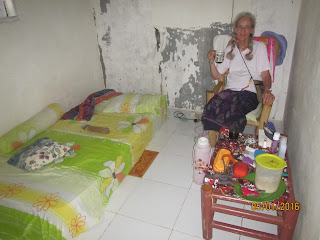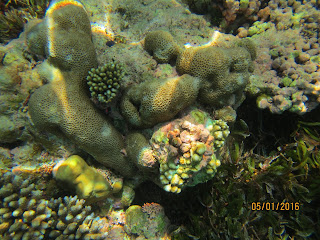WAKATOBI, Sulawesi Tenggara
Wakatobi is composed of 4 main islands – WAngi Wangi, which has the capital, Wanci: KAdelupa: TOmia: BIlongi.
Ekeng and I flew to Wanci, and stayed with Wandi and his family, good friends of Linda’s and Yasril’s. Their house was amazingly well-suited to the climate, with thick walls, no ceiling, a high roof and no eaves. Even the mozzies didn’t find me on the first night.
Wandi took us to the resort of Patuno to see the coastline, and later we went to the popular local beach to snorkel. Even though there was constant traffic from the many ski and banana boats that provide local entertainment, the coral and marine life seems to be healthy, with no fish bombing damage.
Next day Ekeng and I went on the small local ferry to Tomia – 50 or so people in a low-ceilinged modern fibreglass boat with inadequate ventilation. After 3 hours, I think everyone was relieved to get a good dose of oxygen.
We were met in Tomia, and transported by sepeda motor to Desa Kulati at the other end of the island where Ekeng is well-known as producer of their eco-tourism movie. Bapak Tua, the community leader, was proud to show the certificate won by the village for their efforts in eco-tourism development.
From the cliff top near the village we had a clear view of fish in the water below, with large chunks of land that have fallen off over time making many green islets along the coastline.
The tradition of coffee-making in Tomia is a little unusual, even in Indonesia: each person is supposed to know how they like it, so hot water, kopi tubruk [ground coffee] and gula pasir [white sugar] – but no susu [milk] – is provided to make your own
My homestay was 3 houses away from Ekeng’s, so I was still able to hear his distinctive laugh at midnight. I was up before 6.00, not quite early enough to see the sunrise.
We went out in a fishing boat along the coast to snorkel. Hanafi and Kazman, our local guides, were like fish themselves, diving deep with only the snorkel. The variety of fish and coral is enormous, with the remains of a shipwreck a popular spot to visit – I saw my first Lion Fish.
There is some fish bombing damage but this practice is now banned within the Wakatobi waters, a ban that is certainly enforced by this village.
Villagers brought lunch to the beach by motorbike – rice and grilled fish and vegetables – which we ate on the coral sand beach under the cliffs.
Ekeng talked with the village leaders, recording their traditional stories for me. I plan to translate them to return them to the community as bilingual stories. I hope this will preserve the particular stories related to this village, and also encourage the local children to learn English.
Next day it was time to return to Wanci, thankfully in a boat with only about 12 people, so there was far less “kepanasan” [heat stress] for everyone.
Next day, we visited Pulau Kambode, an island opposite the port of Wanci, which though only small, boasts entrance gates to co-joined villages of tidy paved narrow streets suited to the principal vehicles, sepeda and sepeda motor [bicycle and motor bike] with fenced yards and wooden houses.
With a detailed map of the island at the port and signs encouraging everyone to “leave only footprints”, tourism is clearly a priority. We hired a tiga roda [3 wheeler] whose driver was aged about 12, with crew of 2 younger boys. We sat on planks across the back of the tray, travelling along the flat shoreline road to a large shallow lake, Danau Tailaronto’oge, which teemed with small fish. It also had jellyfish, so must have connection with the sea, through the coral.
The ferry back to Wanci had a crew of two; one aged about 25, the other a boy who surely couldn’t have been more than 6, who barely had the strength to push us off from the pier. However he piloted the boat very capably, though his view was restricted by the spokes of the wheel and the passengers.
At the keraton (original place of government) in Wanci’s hilltop village of Liya, we met the Kepala Desa [village head] and a local historian. The magnificent old trees make it a beautiful place, with significant walls still standing, even though they were built without any bonding material. Founded in 12th Century by a Raja from Pulau Buton, there are certainly stories to be collected there next time.
Near the airport are 3 very small islands with walking access at low tide: Linda, Yasril and friends stayed there for a night. After more, even better, snorkelling, and wonderful food, especially local specialties of kasuami from cassava, and heloa sari [with fish and coconut], it’s not surprising we were sad to leave.
So glad I have finally visited Wakatobi that I have heard so much about. Thanks to good friend Ekeng.




































0 comments:
Post a Comment